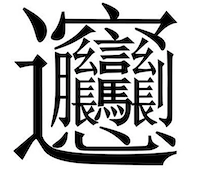
A complex Language
The famous Chinese author Lu Xun (鲁迅) once said: If Chinese characters aren’t destroyed, China will die. This was in the early 90's before simplified characters existed.
Lu Xun thought that the complexity of the Chinese language was one of the main reasons why China was falling behind the rest of the world. Literacy rates were at only 20% due to the poor education system but also because students struggled to learn reading and writing which in turn hindered economic growths. An average Chinese word consisted of up to 100 strokes. To make matter worse multiple variants of the same character were in use and their pronunciation varied widely based on regions and dialects. Even scholars weren’t able to read and write all Chinese words.
In the 1950 the Communist Party of China reformed the writing system and simplified over 8000 characters. Within a few decades the literacy rates improved across the country but many believe that the modernisation of the language came at a high cost.
Cultural costs of modernisation
Many simplified characters lost a part of their pictographic nature and beauty. The character for love (爱) for example, used to have the stoke combination ‘heart’ (心) in its centre. In the modern version of love, however, the heart was eliminated. Nevertheless, aesthetic or historical reasons couldn’t outweigh the benefits that the new writing system had to offer. It was soon spreading in Asia and was also adapted in other countries such as Singapore or Malaysia.
The Pinyin system
The Pinyin system, was the last major development that molded Chinese into the modern language of today. Pinyin, a method for writing Chinese in roman letter rather than Chinese characters was not developed until 1970ties.
Chinese scholars who had studied in America invented a system that used roman letters to know the pronunciation of Chinese characters. It was a revolutionary concept that had a substantial impact on raising literacy rates in China and also lowered the learning barriers for foreign students as they were already familiar with the Latin writing system. If you are a Chinese students you could probably not imagine learning Chinese without Pinyin!